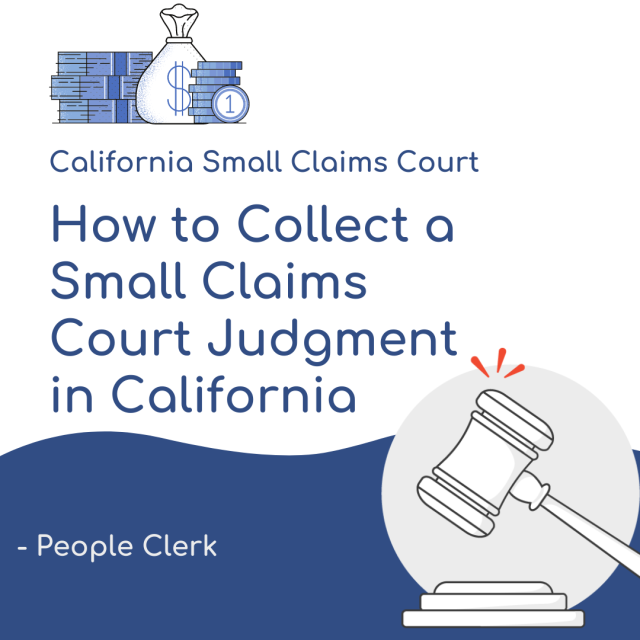People Clerk helps you with your small claims court lawsuit.
Get StartedContents
You won your California small claims court case, now, how can you collect the judgment in a California small claims court? If the Judgment Debtor (the person who lost the case) does not pay you, you can take their wages, cars, property, rental income, etc. You have 10 years to collect the judgment (and can renew that time period for another 10 years). Read on to learn how to collect on your small claims court lawsuit.
In this article, learn about:
Small Claims Court Terminology (Judgment Creditor, Judgment Debtor).
What to do If the Judgment Debtor fails to pay
How to Figure out what assets the Judgment Debtor has
How long does a judgment debtor have to pay a California small claims court judgment?
Terminology
The person who wins the lawsuit and is owed money becomes the Judgment Creditor.
The person who loses the lawsuit and owes money becomes the Judgment Debtor.
Wait 30 days from Entry of Judgment
Why? During those 30 days after the entry of judgment, the Judgment Debtor may:
pay you.
ask the court for a payment plan.
if they showed up for the trial, appeal the decision.
file a Motion to Vacate the Judgment if they did not show up for the trial
send you a Judgment Debtor's Statement of Assets.
What If the Judgment Debtor pays you?
You will have to file an Acknowledgement of Satisfaction of Judgment (Form SC-290).
If you fail to file this form, you may have to pay the Judgment Debtor damages and a penalty.
What to do If the Judgment Debtor fails to pay
If the Judgment Debtor did not take any of the steps above within 30 days of the entry of judgment, now what?
Step 1: Ask the Judgment Debtor to Pay You.
You want to start by simply asking the Judgment Debtor to pay you. Write a letter to the Judgment Debtor requesting payment after 30 days of the entry of Judgment. You ideally want to do this in the form of a letter so that you can keep it for your records. In the letter, you should:
include the amount of the court's judgment;
include where the Judgment Debtor should send you payment (ideally using a check just in case you need to trace this information later);
remind the Judgment Debtor that if they don't pay you, their wages, money, and property may be taken away to pay the claim;
remind the Judgment Debtor that interest can be charged for every day they delay paying you;
include a deadline for payment and if they don't meet that deadline you will take further action to collect on the judgment;
offer a payment plan if you feel that it would be easier for them to pay you that way;
remind the Judgment Debtor that if they don't want to pay you directly, they can pay the court (and you would later collect from the court).
You will find that most collections disputes will be sorted out by simply requesting the Judgment Debtor to pay.
Step 2: Figure out what assets the Judgment Debtor has.
If the letter requesting payment of the judgment does not work, now what? You need to figure out what assets the Judgment Debtor has. If you already know this, skip to Step 3.
Judgment Debtor's Statement of Assets
First off, within 30 days of mailing entry of judgment (or if the court handed it to the Judgment Debtor in the courtroom, the count 30 days from that day), the Judgment Debtor was supposed to send you a form called Judgment Debtor's Statement of Assets (Form SC-133). This form outlines the Judgment Debtor's assets that can be used for collection.
However, very often, Judgment Debtors fail to send the Judgment Debtor's Statement of Assets (Form SC-133). If the Judgment Debtor does not send you that form, you can request that they pay you attorney fees and other penalties for failing to return that form.
Next, if the Judgment Debtor does not send you Judgment Debtor's Statement of Assets, you will need to file an Application and Order to Produce Statement of Assets and to Appear for Examination (Form SC-134). This form will require the Judgment Debtor to return to court and provide Judgment Debtor's Statement of Assets. If Judgment Debtor does not show up a warrant may be issued for their arrest.
Fill out Application and Order to Produce Statement of Assets and to Appear for Examination (Form SC-134). You fill out the top part of the form (Plaintiff name, address, and telephone number and Defendant name address and telephone number, if all the information doesn't fit attach another sheet of paper with the missing information), leave the section in the middle titled "Order to Produce Statement of Assets and to Appear for Examination" blank (this is what the court will fill out), and fill out the bottom section titled "Application for this Order" (under "A" include your name as the Judgment Creditor and the Judgment Debtor's name).
File the Application and Order to Produce Statement of Assets and to Appear for Examination (Form SC-134) + Pay a Filing Fee of $60 (you can add this as a cost that the Judgment Debtor will have to pay as part of what they owe you). To be on the safe-side bring at least 3 copies (one for the court, one for you, one for the Judgment Debtor) of the form. You should also bring a postage-paid self-addressed stamped envelope just in case.
Wait until the court agrees to grant your Application and Order to Produce Statement of Assets and to Appear for Examination (Form SC-134). This usually takes around 10 days. If you provided the court with extra copies and a postage-paid self-addressed stamped envelope when you filed the form, you will receive in the mail a copy of the signed form and a hearing date.
Serve a filed copy of the Application and Order to Produce Statement of Assets and to Appear for Examination (Form SC-134) + a copy of Judgment Debtor's Statement of Assets (Form SC-133). You are only able to utilize personal service meaning the
Judgment Debtor must themselves be served (you CANNOT use substituted service). This means you will need to hire the sheriff, marshall, or a registered process server
to personally serve the Judgment Debtor (a friend cannot serve this form if you want a civil arrest warrant to be issued). Additionally, you must serve the Judgment Debtor
at least 10 calendar days before the hearing and have Proof of Service (SC-104)
filed with the court.
Attend the Examination hearing.
Be prepared to ask the Judgment Debtor about assets they have that you can collect from (where they work, do they own a property + how much is the value of the property).
Note: It is highly suggested you fill out, file, and serve and Small Claims Subpoena for Personal Appearance and Production of Documents at Trial or Hearing and Declaration (Form SC-107) which, if granted, will order the Judgment Debtor to bring documents to the hearing such as bank statements.
Step 3: Seize the Judgment Debtor's Assets.
Once you know which assets the Judgment Debtor has, you can work on seizing the assets. Stay posted for an article on this topic!
FAQ
How long does a judgment debtor have to pay a California small claims court judgment?
In California small claims court, if the party who lost the case (“Judgment Debtor”) does not pay within 30 days from when the judgment was mailed to the parties (sometimes it gets handed directly to parties during the hearing), then the collection process begins.
Once the collection process begins, additional costs are incurred by the Judgment Creditor which can be added to the judgment. Ideally, a Judgment Debtor should pay before the collections process begins.

Camila Lopez
Legal Educator at JusticeDirect. Camila holds a law degree and is a certified mediator. Her passion is breaking down complicated legal processes so that people without an attorney can get justice.
